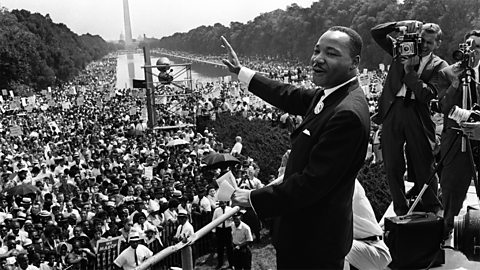The role of Martin Luther King
Under the leadership of Martin Luther King, the civil rights movement adopted tactics of non-violence, peaceful protest and civil disobedience.
The video below looks at Martin Luther King's opinion on non-violent protest.
King had been impressed by the tactics of Mahatma Gandhi who had used non-violent protest in India in the 1940s against the British rulers.

He outlined his vision of non-violence when speaking during the Montgomery Bus Boycott (1955 - 1956)Civil rights protest in Montgomery, Alabama, between 1955 - 1956 in demonstration against segregated seating on buses. It lead to the bus system being integrated. One of the main leaders of the protest, Reverend Martin Luther King Jr., went on to become a key figure in the American Civil Rights Movement..
He said,in our protest there will be no cross burnings. No white person will be taken from his house by a hooded Negro mob and brutally murdered. There will be no threats or bullying
.
King thought that civil disobedience was necessary to increase civil rights and believed that if a law was wrong then the citizens of the country had the right to protest against that law.
He was not worried about the high number of arrests that might occur. Instead, he saw it as an opportunity to gain even more publicity.
The March on Washington
The March on Washington was organised to try and force the Government into improving Civil Rights.The purpose of the March was to gain publicity for the new Civil Rights Bill.
On August 28, 1963, 250,000 people gathered at the Lincoln Memorial, and Martin Luther King made his famous I have a dream
speech to a worldwide audience.